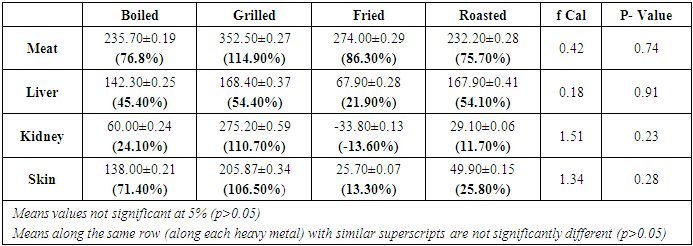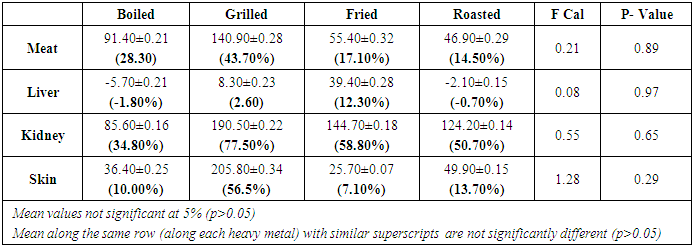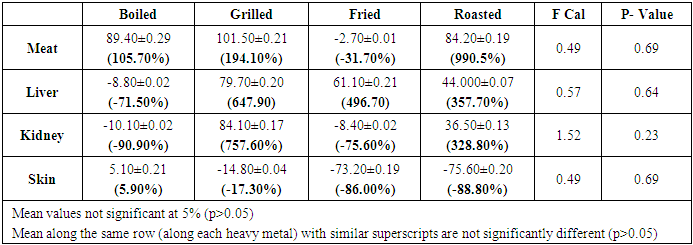-
Paper Information
- Paper Submission
-
Journal Information
- About This Journal
- Editorial Board
- Current Issue
- Archive
- Author Guidelines
- Contact Us
Food and Public Health
p-ISSN: 2162-9412 e-ISSN: 2162-8440
2021; 11(3): 53-59
doi:10.5923/j.fph.20211103.01
Received: Oct. 31, 2021; Accepted: Nov. 24, 2021; Published: Dec. 24, 2021

Cooking Increased the Concentration of Occurring Heavy Metal Residues in Chevon Sold in Lagos State, Nigeria
Sigbeku O. T.1, A. O. Mosuro2, O. A. Ogunwole3, A. B. Omojola4
1Veterinary Medicine and Allied Products Directorate, National Agency for Food and Drug Administration and Control, Lagos, Nigeria
2Faculty of Public Health, Department of Human Nutrition and Dietetics, Lead City University, Ibadan
3Agricultural Biochemistry & Nutrition Unit, Department of Animal Science, University of Ibadan, Ibadan, Nigeria
4Animal Products & Processing Unit, Department of Animal Science, University of Ibadan, Ibadan, Nigeria
Correspondence to: A. B. Omojola, Animal Products & Processing Unit, Department of Animal Science, University of Ibadan, Ibadan, Nigeria.
| Email: |  |
Copyright © 2021 The Author(s). Published by Scientific & Academic Publishing.
This work is licensed under the Creative Commons Attribution International License (CC BY).
http://creativecommons.org/licenses/by/4.0/

In Nigeria, goats are raised under extensive system of management solely for chevon. The animals could be exposed to feeds and water contaminated with heavy metals (HM) during scavenging and browsing. The HM residues (HMR) in meat and meat products constitute health hazards in humans when consumed. However, information on HM concentration in raw and cooked chevon have not been adequately documented. Thus, occurrence of HMR in raw chevon and the effect of cooking on HMR in chevon sold in Lagos state was evaluated in this study. Samples of Chevon (n=60) each taken from muscle, liver, kidney, and skin were randomly purchased from five purposively selected markets in each of the three senatorial districts of the state (East, West and Central). The HMR (ppb) concentrations of the raw, boiled, grilled, fried, and roasted chevon samples were analyzed. Results revealed that lead concentrations in raw muscle (306.7±0.1), liver (309.3±0.2), kidney (248.4±0.1) and skin (193.1±0.7), increased significantly (p<0.05) to 542.4±0.2, 449.6±0.3, 320.3±0.2 and 331.1±0.2 (boiled), 659.2±0.3, 415.3±0.2, 523.6±0.6 and 398.9±0.4 (grilled), 580.7±0.3, 377.1±0.3, 214.6±0.1 and 218.8±0.1 (fried), 538.9±0.3, 369.2±0.3, 277.5±0.1 and 243.0±0.1 (roasted), respectively. Cadmium and mercury in raw muscle, liver, kidney, and skin similarly increased (p<0.05) by the different cooking methods. Arsenic was not detected. The level of lead in the chevon was above the recommended 100 ppb approved for meat by Codex Alimentarius. Lead, cadmium, and mercury residues in raw chevon samples were profoundly increased by the different cooking methods.
Keywords: Heavy metals, Chevon, Heavy metals residue, Cooking methods
Cite this paper: Sigbeku O. T., A. O. Mosuro, O. A. Ogunwole, A. B. Omojola, Cooking Increased the Concentration of Occurring Heavy Metal Residues in Chevon Sold in Lagos State, Nigeria, Food and Public Health, Vol. 11 No. 3, 2021, pp. 53-59. doi: 10.5923/j.fph.20211103.01.
Article Outline
1. Introduction
- Livestock production, distribution and sale in Nigeria are age-long business that dominates the northern and southern parts of the country. Farmers and livestock merchants have long-time trading relationships which existed across generations [1] [2]. Livestock, especially large and small ruminants, is mainly raised under extensive system of management in the northern area of the country due to favorable climate conditions, availability of farm residues which the animal can easily assess and feed on and the absence of animal threatening diseases such as trypanosomiasis. This system of management is affordable by rural farmers.Goats were reported to be commonly raised in the rural areas by housewives, mostly for chevon [3]. Meat and meat products including chevon was reported to be readily available in both informal local markets and the formal markets (distributors/retailers shopping malls) in the rural and urban areas across Nigeria [4]. Most chevon is obtained from goats raised on free-range management system. These animals are exposed to various environmental hazards and poor-quality inputs such as feed and water. They are often kept under poor conditions, and these could have a direct effect on the production level and also the quality of their products. Goats, for instance, are known to be browsers and scavengers [3]. Goats enjoy moving around to fend for feed through grazing and browsing and would drink water from any available source irrespective of the quality and safety [3]. Presently in Lagos State, live goat is sourced from other parts of Nigeria, handled, and managed in confinement by the suppliers, and retailed prior to their disposal in a manner directly influenced by the age and levels of education of the practitioners [5].In March 2010, lead poisoning was reported in Zamfara State, one of the northwest states of Nigeria [6]. Investigation of the report revealed that human activities, such as mining, in the community over a long period resulted in the contamination of soil, farmland, crops and the environment. Average concentration of lead on farmland in the contaminated area was reported to be 1266 ppm which is far above the recommended level of 300 ppm [7]. The report also revealed a high level of lead concentration in sorghum and cowpea leaves to the tune of 3,500% higher than the recommended level of 50 ppm in the edible crop [8]. High level of lead was also reported in flowing stream water in the community. The UNEP mission sent to the community found a high concentration of lead (up to 1000 ppm; 10 times higher than the exposure limit suggested by FAO for livestock) in ponds, rivers, and lakes [9]. These findings suggest that the consumption of meat and meat products of animals raised in such exposed areas would be a veritable route for human food chain contamination since dead found animals are often consumed in most communities in Nigeria [9].A high level of lead concentration was reported [10] in the blood sample of animals raised in Anka Local Government Area of Zamfara State. About 71.9% of sampled goats had over 5 ppm of lead in their bloodstream attributable to the free-range management system of livestock production in the area. Continuous ingestion of heavy metals through feed and water could result to adaptation when within the tolerable level, may result in deposition of excess metals in the animal tissues. Earlier studies were focused on the heavy metal content in the blood of animals [6,9,10]. Report of HMR in tissues and meat of goat in Akinyele, Oyo State [11] as well as those of Maiduguri [12]. The application of heat affects some changes in the food which includes making the food more palatable, easy to chew and digestible. The act helps to bring out the characteristic flavour, texture, and aroma. The aroma of a meat sample in most cases is peculiar to the animal species [15]. In the past, application of heat to meat includes roasting (done by exposing the meat to naked fire), boiling, grilling, frying and recently, microwaving [16]. Roasting and microwaving methods of cooking meat have been shown to be the best from the nutrition point of view due to observable improvement in meat amino acid index [16]. This shows that the heat helps in the breakdown of the amino acid bonds and making it more readily available in the cooked meat. Also, cooking was noted to help reduce the concentration of saturated fatty acid in meat. This is achieved when the cooking heat melts the meat marbling fats which is released with moist content, thereby increasing the meat dry matter [16]. Cooking heat has also been reported to help in improving the meat tenderness and aid the pleasant flavour characteristic. The cooking was found to have a significant influence on the nutritional content depending on the type of cooking method employed [17]. Cooking with regulated heat was also reported to help in reducing meat microbial load [13] [14]. Scanty reports on effects of cooking on HM residues in meat revealed that cooking increased the concentration of residues which bond with proteins while it reduced the residues that bond with water and fat [18]. Frying and boiling was also reported to increase the residue of lead while smoking and grilling reduced its concentration [18] while the concentration of cadmium was not significantly affected by any of the cooking methods. The present study was therefore, aimed at assessing the occurrence of HMR in raw tissues and chevon sold in the open market in Lagos State, Nigeria and also determine the effect of different cooking methods on heavy metal residues in the chevon.
2. Materials and Methods
2.1. Study Area
- The study was carried out in Lagos State, Nigeria (6° 31' 26" N 3° 22' 43" E). The state was divided into three along senatorial district line viz: Lagos Central, Lagos East and Lagos West. The sample preparation and analyses were done at the Meat Science Laboratory of the University of Ibadan, Nigeria and The Central Food Laboratory, National Agency for Food and Drug Administration and Control (NAFDAC) Oshodi Lagos State, Nigeria.
2.2. Sample Collection
- The meat, liver, kidney, and skin samples, which were offered for sale at the randomly selected markets, were purchased and transported in ice pack cooler to the Meat Science Laboratory, University of Ibadan. A total of 60 samples each of meat, liver, kidney, and skin were collected. Each sample was randomly divided into four equal parts of approximately 80 grams and allotted to the four different cookery methods, boiling, frying, grilling, and roasting after taking the raw sample for analysis.
2.3. Experimental Design
- The experimental design was completely randomized design. In the raw samples, the four meat types served as treatment while the market of purchase served as replicate. However, in the cooked samples, the cookery methods served as treatment while the market of purchase also served as replicate (amounting to 15 replicates).
2.4. Sample Preparation
- The samples preparation was accomplished at the Meat Science Laboratory of the University of Ibadan as follows:
2.4.1. Boiling
- The meat samples were put into a boiling deionized water and cooked to a core temperature of 72°C after which the samples were drained in sieve and allowed to cool to room temperature. About 10 grams each of the cooked samples were homogenized using multi-function blender (model – blendtec, CTB 2). The sample was properly labelled for digestion.
2.4.2. Frying
- The frying was done with a certified cooking oil brand named ‘mamador’ with NAFDAC registration number B1-7532, batch number 1336510. The oil was heated to 114.5°C in a stainless-steel frying pan. Each of the meat sample from each market was deep fried to a golden-brown colour at about 126°C and a core temperature of 72°C was achieved. The fried samples were allowed to cool down to room temperature, and 10g of each sample was homogenised using multi-function blender, blendtec make CTB 2 model and properly labelled for digestion.
2.4.3. Grilling
- Grilling was done with grilling machine (model - Char-Broil Performance 475). The grill was heated to about 215°C before setting the meat samples. Each sample was set in the machine and heated up to 245°C for 10 minutes to achieve samples core temperature of 72°C. The grilled samples were allowed to cool before homogenising about 10g of each sample using multi-functional blender, blendtec, model CTB 2 and properly labelled for digestion.
2.4.4. Roasting
- The samples were set in a warm oven (model - Crown Star electric oven 11L) and roasted at 180°C for 25 minutes to achieve an internal temperature of 72°C. The roasted samples were treated as stated above and equally homogenised and properly labelled and stored until further use.
2.5. Sample Digestion
- The homogenised samples were properly set out in the digestion block and 1g was weighed out and placed in a test tube. 70% conc. Nitric acid and 70% conc. Perchloric acid were mixed in ratio of 1:1 (equal volume). The mixed acid solution (10 ml) was added to the sample under fume hood and allowed to undergo wet digestion by leaving the sample overnight (12 to 14 hours). The sample was transferred to heating block and gradually heated to 125°C over 10 minutes and to 205°C over 4 minutes. The clear digest was filled into the ICP MS (model Elan DRC-6 - model of Perkin Sciex) sampling tray for reading. Reading was taken at ppm (mg per kg) for the four metals of interest viz: Pb, As, Cd and Hg.
2.6. Statistical Analysis
- The means of the residue obtained in the cooked samples was compared with those in the raw samples using the formula:
 The values obtained was converted to percentage increased in the residue value using the formula:
The values obtained was converted to percentage increased in the residue value using the formula: Where MVraw is the Mean Value in Raw Meat MVcooked is the Mean Value in Cooked Meat The mean values obtained in the cooked meat were also compared with codex recommended Maximum Residue Limits (MRL) for meat.Data were subjected to analysis of variance using SSPS (1999) package. Treatment means were separated with DMRT at α0.05.
Where MVraw is the Mean Value in Raw Meat MVcooked is the Mean Value in Cooked Meat The mean values obtained in the cooked meat were also compared with codex recommended Maximum Residue Limits (MRL) for meat.Data were subjected to analysis of variance using SSPS (1999) package. Treatment means were separated with DMRT at α0.05.3. Results
- The concentration of heavy metals residue in raw goat meat samples is presented in Table 1. Arsenic was not detected in any of the meat samples. However, Pb residue (ppb) was found in muscle (306.7±0.120, liver (309.30±0.17), kidney (248.40±0.08), and skin (193.10±0.68). Cadmium and Hg were also detected. The residue level of Cd in muscle, liver, kidney, and skin were 322.30±0.23, 322.90±0.19, 245.80±0.17 and 363.90±0.15 ppb, respectively; while those of Hg in muscle, liver, kidney, and skin were 8.50±0.01, 12.30±0.01, 11.10±0.02 and 85.10±0.02 ppb, respectively.
|
|
|
|
|
|
|
4. Discussion
- The concentration of HMR in the muscle, kidney liver and skin samples after subjection to different cooking methods viz: frying, boiling, grilling, and roasting, resulted in increased concentration of the residues across the samples. This could be because of the increased dry matter incident to the removal of the water bonds in the meat fragments and the fat marbling due to cooking heat. This is similar to previous work on boiling and frying cookery methods which resulted in increased concentration of Pb residue in meat samples [18]. Though, a decrease in concentration of Pb residue was reported to be due to grilling, contrary to findings in this report. However, such trend was observed on the residue of Hg in the skin samples. The Pb concentration in the meat sample was significantly different from other muscle types because of frying and roasting, this could suggest that meat sample texture may have a role to play in the HMR bonding in the samples’ fragments. The concentration of the metals depends on the ligand bonds. The sulphur group are bonded to either double or single bonds. On the other hand, some variation was observed on some samples such as the concentration of Pb in fried kidney which reduced by 13.60%. This suggests that kidney is best fried to reduce residue of Pb in it. Similarly, the residue of Hg in fried meat was reduced by 31.70%, boiled kidney was reduced by 90.90% and roasted skin was reduced by 88.80%. This showed that cooking method could be used to reduce the concentration of some of the heavy metals and subsequently reduce the health hazards associated with HMR in chevon. The residue of Cd and Hg in meat, liver, kidney and skin were found to be below codex MRL. This agreed with findings in previous works [12] [11]. Although, the latter reported that Cd was above codex MRL from the sample taken from markets in Oyo state, but the presence of these metals in meat was a treat to meat safety and human health, especially, the children that would be more vulnerable. Although, the values were not significantly different (p<0.05) within the samples and across the metals, but the presence of the residue was a threat to public health because Cd antagonises Ca2+ metabolically in digestion thereby resulting to serious Ca deficiency amidst other effect such as kidney, bone, and lung diseases [19].
5. Conclusions
- Most cooking methods enhanced the heavy metal residues concentration in goat meat (muscle), kidney, liver and skin. Reduced concentration was recorded in some other instances. Lead residues in meat samples were above recommended codex Maximum Residue Limit, which has serious implications on public health.
 Abstract
Abstract Reference
Reference Full-Text PDF
Full-Text PDF Full-text HTML
Full-text HTML





